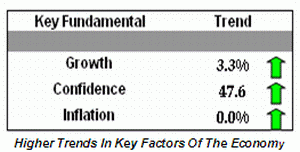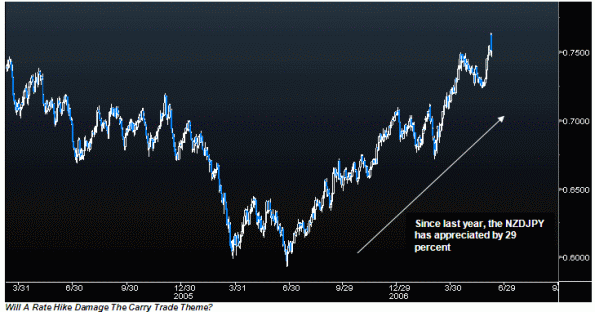| Could the Bank of Japan Move Earlier Than Expected? |
| By John Kicklighter |
Published
06/13/2007
|
Currency
|
Unrated
|
|
|
|
Could the Bank of Japan Move Earlier Than Expected?
Given the recent string of central bank surprises in the past month or so, one has to wonder whether or not the currency markets may be in for a doozey when Bank of Japan officials meet this week. Although the market is overwhelmingly confident that rates will not change this time around, there is a small contingent that believes either a rate hike or considerably more hawkish comments could ultimately emerge. And there’s plenty of economic data to back up this speculation.
Some will remember to the beginning of the year when the Canadian dollar was discarded as a nonstarter currency. However, with economic growth in full force recently, the underlying currency has been on a 1000 basis point tear against the US dollar over the past several months. The same can be said of the world’s second largest economy. With things just beginning to change slightly in Japan, conditions may be prime for a breakout.
What’s Changed In Japan?
Since the beginning of the year, economic fundamentals have improved significantly. First and foremost, inflationary pressures have remained positive for consecutive months. Although still hovering near the zero percent level, current price increases are far from the deflationary levels that were clearly evident the previous year. Unfortunately, this has been spurred on by rising producer prices and corporations passing the higher cost onto the market, rather than the legitimacy of higher prices on demand. Domestic consumption continues to remain weak in the economy, helping to keep increases at bay. The notion lends to speculation that should consumers pick up spending habits, the figure will very well increase, grabbing the attention of the Bank of Japan. However, as policy makers have noted, consumer inflation is not the sole reason to lift rates. And so we turn to growth. Recently, gross domestic product, a measure of expansion in the economy, outpaced both the Eurozone and the United States. Posting a second consecutive quarter of expansion, annualized growth hit 3.3 percent in the second quarter of the year. The figure, founded on a strong export sector, is eventually going to lead to higher rates of inflation as productivity and employment emerge. Bank of Japan Governor Toshihiko Fukui is confirming the bullish bias, forecasting that economic growth is to remain above trend, expanding at 2 percent well into 2008. Ultimately, the notion is likely to serve as the impetus for officials to increase rates ahead of schedule even if pressure comes in the form of governmental bantering.

Political Pressure – In All Forms
An earlier move would also help divert any potentially rising focus on the undervaluation of the Japanese yen, keeping the world fixated on the Chinese yuan. Traders will hark back to the era of 2003-2004 when the Japanese yen was the focus of G8 meetings as global trade partners worried about the competitiveness of Japanese made goods. This purported considerable intervention by the Bank of Japan in order to sustain a fundamental value in the yen as speculators sold the currency on the likelihood that policymakers wouldn’t intervene as much. A costly endeavor by the BOJ. However, now the attention, at a relatively high level, is being placed on the Chinese yuan. With protectionist legislation targeting China likely to emerge in the US in the next week or so, Japanese officials will support a disassociation from their regional trade partner as future legislation could endanger their trade relationships as well. The underlying theme is well publicized as both Chinese and US officials continually jawbone protectionist themes on the heels of what seemed to be an ineffective strategic dialogue. On the other hand, the move would also have domestic implications as the timing of a surprise rate hike would conflict with the LDP elections in the following month. Here, central bankers would be at odds as to their national duty to follow in line with the headline government, which continues to remain monetarily “accommodative”. However, should the central bank feel the need to profess their political independence, in line with most other industrialized central banks, this couldn’t be a better time.

Will This Jeopardize The Carry?
Although the overwhelming theory is one of a cataclysmic decline in the carry trade notion, there still remains the likelihood that the FX market will rebound from considerable profit taking, if it happens at all. Still offering a low cost funding vehicle, the Japanese yen will likely continue to be favored by carry traders until fundamental risk becomes too bearable in some higher yielding currencies. As a result, currencies like the New Zealand dollar, Australian dollar, and British Pound will continue to remain hot topics in the FX market as the basis point spread remains considerably wide. In the case of the New Zealand dollar, which has made one of the most impressive runs as of late, the difference between interest rates still offers the investor 725 basis points against the yen if the Bank of Japan elects to raise rates. There may be even more to come as the market continues to price in the likelihood that rates will rise further in New Zealand at the tail end of the year.
Conclusion
Given all these facts, central bankers essentially have the economic support that is required to heavily consider lifting rates in the near future. And why not? With focus turning to the overall growth of the nation and not just its consumer price component, things are looking rather interest rate bullish. The only caveat is and always has been the consumer. With wage growth still rather tepid compared to other industrialized nations, consumption continues to suppress any real rate of growth in the economy. This factor may be the only thing stopping policy makers in altering rates at the moment, leaving plenty of speculation for the months to come.
Richard Lee is a Currency Strategist at FXCM.
|